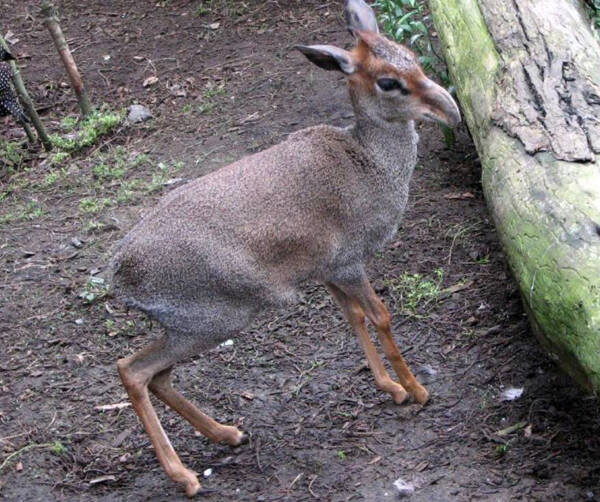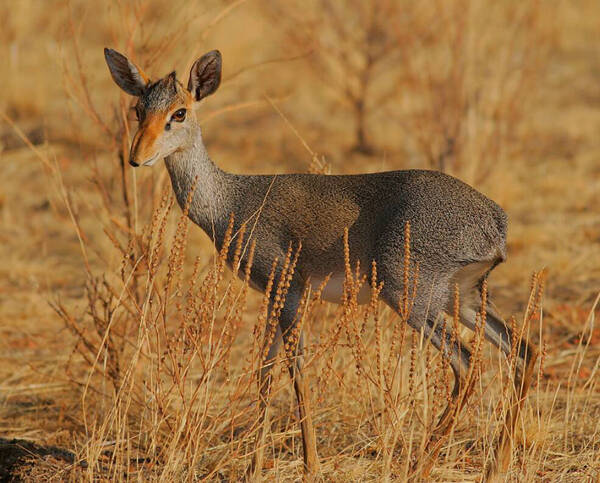Madoquaguentheri
IUCN
LCBasic Information
Scientific classification
- name:Madoquaguentheri
- Scientific Name:Madoquaguentheri
- Outline:Ungulata
- Family:Artiodactyla Bovidae Oryctolagus
Vital signs
- length:50-60cm
- Weight:3-5kg
- lifetime:About 10 years
Feature
A small, slender antelope with a long neck and a small head.
Distribution and Habitat
The Gunn's antelope is endemic to the arid zone of Somalia in East Africa. They are found in Somalia (excluding the extreme northeastern and northwest and the central coastal belt), the eastern and southern lowlands of Ethiopia, northern and eastern Kenya, northeastern Uganda and the extreme southeastern South Sudan.
They live from sea level to 2,100 meters above sea level. Preferred habitats include arid and semi-arid thorns, tropical savannas, woodlands and riverine grasslands. Characteristically, there is little scrub, as the species does not like to be far from vegetation. However, they cannot thrive in densely growing jungles due to impeded vision and movement. The Gunn's antelope is most abundant in overgrazed or disturbed areas, where food levels are acceptable. They prefer roadside scrub and regenerated old fields. The habitat ranges from sandy soils to flat land and low rocky hills.
Appearance
Gen's antelope weighs 3-5 kilograms. It is a small and slender antelope with a long neck and a small head. Their hindquarters are usually set at shoulder height or higher. The fur is soft and ranges in color from yellowish-gray to reddish-brown on the dorsal side and from white to gray on the ventral side. The short tail is 3-5 cm, hairy on the dorsal side and bare on the ventral side. The male's black horn is very short, up to 9.8 cm. Curving back or straight from the sides, these corners become gradually rounded and ring-shaped toward the tip. Sometimes they are obscured by a tuft of hair on the forehead. The eyes of this species are large and dark. The preorbital lids and glands are also black. The antelope's ears are large and white inside. Their legs are thin and long, with black hooves pointing forward. The accessory hooves are small. Since the female is larger and has no horns, the antelope is sexually dimorphic. Both sexes have hair on top of their heads, but mal
Details
Madoquaguentheri (scientific name: Madoquaguentheri) English: Guenther's Dik-dik, Günther's Dik-dik, French: Dik-dik de Günther, Somalia: Ghussli, there are 2 subspecies.

The Gunn's gazelle is mainly active during the day, but also active at night, usually until about 3 a.m., and then rest until dawn. They usually form a family group consisting of an adult couple and an immature fawn. The fawn is usually driven away during the female's first estrus and after the birth of a new fawn. The estrus lasts about two days, and the male will show aggressive behavior. Sometimes pairs appear within sight of each other. The reason they are seen occasionally is that pairs are not always together. If a member of a pair leaves or dies, a replacement may join the group soon after, otherwise the surviving animal may live alone. Territories are defined by dung piles of about 30 cm in diameter deposited at opposite boundaries. This behavior may be the first behavior to declare territory, and both males and females exhibit this behavior, but males tend to do it more than females. Males dig the soil with their paws and then urinate and defecate. Males follow females and then urinate and defecate in the same place. Post-orbital gland secretions are also used to mark territories. Another way to define territory is through sound. Males usually whistle when disturbed. Intrusion into their territory causes the antelope to bounce up and then gash when landing. This whistling sounds like "zik-zik" or "dik-dik". Males also mark territory by scoring tree trunks with the ripples on their horns. Only males defend territories, and territorial behavior peaks when females are in estrus. Territorial disputes between males are usually symbolic and rarely occur.
Gunn's antelopes are timid animals that seek cover, and even the slightest warning will lead them to seek out tall vegetation and crouch on the ground. Animals that prey on Gunn's antelopes include hyenas, leopards, cheetahs, wild cats, jackals, baboons, eagles, and pythons. The species uses different behaviors to differentiate between these predators. For example, if a leopard is nearby, they will whistle. If a hyena approaches, they will usually just watch. Their defenses include excellent eyesight, agility and speed, and familiarity and knowledge of their territory.
Gunn's antelopes select high vegetation. They feed on specific parts of plants, including leaves, flowers, stems, fruits, seeds and pods of trees and shrubs of various plants. Grasses make up only a small part of their diet (except for flowers and seeds), and they sometimes chew the tender tips of new grasses. This species does not concentrate its feeding on one plant. They are adapted to dry conditions and feed on protein-rich shrubs and trees, as well as several xerophytic succulents. As an alternative to the main plant, they choose from a wide variety of vegetation. The food is varied and usually of high nutritional value. The composition of the diet varies with the season. In the dry season, plant species such as Acacia pinnata, Cyperus spp., Fagara merkeri, Cyperus spp., Harrisonia abyssinica, and Tamarind are the main feeders. In the rainy season, their food includes Acacia trees, Commiphora schimperi, Ipomoea spp., and Leonotis nepetifolia. They also wander through crops and orchards, and like to eat the young shoots of cultivated crops. The species can survive without drinking surface water, obtaining the water it needs from plant juices and dew.

The Gunn's antelopes typically forage near the ground and use their tongue and upper lip to pick up food. They have developed some special methods that allow them to obtain small leaves surrounded by thorns and obtain nutrition in areas that cannot adequately support feeding by large herbivores. These adaptations include a long nose, narrow snout and tongue, and an elongated body. They obtain this food by using their forelimbs to pull down branches from high places, or by standing on their feet, using small branches to support their forelimbs. Sometimes, roots are dug with hooves or horns. The feeding habits of other animals such as primates, rodents, and birds help bring food into the range of the antelope. These animals scatter some pods, buds, leaves, and flowers on the ground when feeding, making them available to the antelope. The antelope usually feeds from dawn to mid-morning, and then again from mid-afternoon until after dark.
The courtship behavior of the antelope is unique. At first, the female slows down her movements and seems dizzy. She keeps her nose straight as she walks past the male. Sometimes she shows the male a tuft of white hair near her rump, then slowly flicks her tail. Males will focus on the female's facial area, especially the preorbital glands.
Young antelopes reach sexual maturity before their first year of age and remain reproductively mature until they are over ten years old. The number of days in estrus for females ranges from 1-7, with an average of 1.48 days. Reproduction is not affected by season and can occur year-round. Low levels of urinary progesterone metabolites before, during, or after estrus also indicate estrus. Gestation is usually 170-180 days, with one calf per litter. Births usually occur twice a year. During delivery, the head emerges first, while the forelimbs are placed alongside the body. This is different from births in other ruminants. Postpartum estrus lasts about ten days. Therefore, mating and delivery occur at the same time of the year. This results in female antelopes being pregnant for most of the year, including the time they are raising their calves.

Male calves usually weigh between 725-792 grams at birth, while females weigh between 560-680 grams. The calves need to be nursed for 3-4 months, but the calves can start eating solid food after about a week. The calves are hidden for the first 2-3 weeks after birth. This period is aided by hiding the female's intake of the birth. The young female stays with her for the first few days after birth. She often leaves for short periods in order to feed, but soon these short periods become longer. The young female eventually nurses 4 times a day: at sunrise, noon, dusk, and sunset. For several months after the period of concealment, the young antelope accompanies both parents. The male does not participate in providing food for the young antelope, but still has a parental relationship. An example of this is that the male will groom the young. Because of this relationship, the male is more tolerant of his young antelope. Even in situations that would normally cause aggression, the young antelope tolerate it. The female uses a calling sound to contact the young antelope and call it out. The young antelope is silent during the day, but may whistle at night.
Newly born young antelopes have the same skin color as young adults. The ears, nose, and legs are also well developed. The horns grow between 7-8 weeks, although at first the towel crest on the head hides the horns. The muzzle reaches its full size at two years of age. At the 34th week, the horn ring appears. At one year and eight months, weight and height reach adult standards.
The Gazelle is common throughout most of its range. East (1999) derived a total population estimate of 511,000 individuals based on an average density of 1.0/km² across the entire inhabited area. Species population density count estimates were obtained from 0.7-1.1/km² in the Somali Highlands and the Ogaden region of Ethiopia (1999). In Omo NP, Ethiopia, a high density of 23.8 km² was observed within a study area of 75 ha in 1988 (Ono et al., 1988). Species trends are generally considered stable.
Listed in the IUCN Red List of Threatened Species in 2016, ver3.1 - Least Concern (LC).
Protect wild animals and stop eating game.
Maintaining ecological balance is everyone's responsibility!








